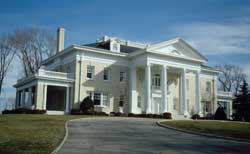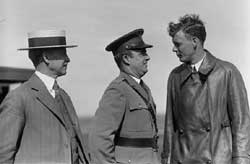
Completed in 1914, Hawthorn Hill in Dayton, Ohio, was designed by Wilbur and Orville Wright with the aid of the Dayton architectural firm of Schenck and Williams. As the Wrights' fame grew so did their need for a larger home that could better accommodate their many guests. Therefore, with the consent of their sister Katharine, the Wright's purchased a 17-acre wooded tract named Hawthorn Hill for the many hawthorn trees covering the hillside. In 1912, shortly after approving the final plans for the house, Wilbur died. Orville dedicated himself to overseeing the construction of the residence, spending as many hours as possible at the construction site. The house was also equipped with many labor saving devices and gadgets of Orville Wright's design including a special system of chains and rods that allowed him to control the furnace from upstairs rooms and an early version of a water softener that purified water for use in a large shower. He fashioned special tools to aid in cleaning the residence, a toaster capable of slicing and browning bread, a buzzer system between the dining room and kitchen and an easy chair with a reading stand and matching adjustable footstool.

Hawthorn Hill, often called Orville's "machine for living," was host to many notable guests such as Thomas Edison, Alexander Graham Bell, Carl Sandburg, Admiral Richard Byrd, King Constantine of Greece and President Franklin D. Roosevelt. One of the most famous guests of Hawthorn Hill arrived on June 22, 1927. Charles Lindbergh, returning to St. Louis just weeks after his nonstop flight over the Atlantic Ocean, stopped in Dayton to visit Orville Wright. At the request of his financial backers Lindbergh was unable to make a public appearance. Disappointed Daytonians gathered outside Hawthorn Hill demanding a glimpse of their hero. Forced to appease the crowd, Lindbergh and Orville Wright made a brief appearance on the balcony and the satisfied crowd dispersed. Following Orville's death January 30, 1948, his family placed the home for sale. Edward Deeds of the National Cash Register Corporation (NCR) purchased the estate, which is still used as a guesthouse for overseas visitors and dignitaries.
Visit the National Park Service Travel American Aviation to learn more about Aviation related Historic Sites.
Last updated: September 3, 2017
